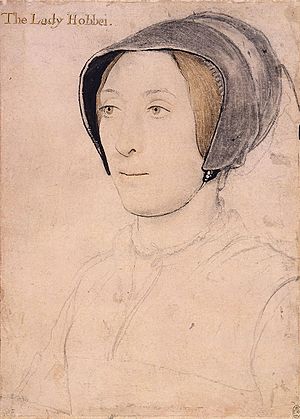Philip Hoby facts for kids
Quick facts for kids
Sir Philip Hoby
|
|
|---|---|

Sir Philip Hoby, Hans Holbein the Younger
|
|
| Born |
Philip Hoby
1505 |
| Died | 31 May 1558 (aged 52–53) |
| Resting place | Bisham church, Berkshire |
| Occupation | English diplomat |
| Spouse(s) | Elizabeth Stonor |
| Parent(s) | William Hoby Catherine Forster |
| Relatives | Edward Hoby (nephew) Thomas Posthumous Hoby (nephew) |
Sir Philip Hoby (born around 1505 – died May 31, 1558) was an important English diplomat in the 1500s. He served as an Ambassador for England to the Holy Roman Empire and Flanders. He was also a member of the Privy Council, a group of advisors to the monarch.
Contents
Early Life and Beliefs
Philip Hoby was likely born in Leominster, England. His father was William Hoby. Philip was the older half-brother of Sir Thomas Hoby, who was also a well-known figure.
Philip Hoby became a diplomat because he supported the Protestant Reformation. This was a major religious movement in Europe that led to the creation of Protestant churches. His support for these changes helped him gain favor with King Henry VIII.
A Diplomat's Career
Early Missions and Royal Portraits
Sir Philip Hoby traveled a lot for the King. He visited Spain and Portugal on royal business. In March 1538, he arrived in Brussels with the famous painter Hans Holbein the Younger.
They were sent by Thomas Cromwell, a key advisor to King Henry VIII. Their mission was to get a portrait of Christina, Duchess of Milan, for the King. Holbein was known as "a man very excellent in makyng of phisanymies" (meaning he was great at painting faces). Hoby helped arrange a three-hour sitting for Holbein with the Duchess. The King was very happy with the portrait when it arrived.
Hoby and Holbein went on another trip to France. They painted Princess Margaret of France. They also visited Joinville to get a portrait of Louise de Guise.
Service to the King
By 1542, Hoby was a gentleman usher in the King's private rooms. In 1543, he was briefly held in the Fleet Prison. This was due to suspicions about his religious beliefs.
After the Siege of Boulogne, Hoby was made a knight. He also received gifts of land and money from the Dissolution of the Monasteries. This was when King Henry VIII closed down many monasteries and took their wealth.
In 1545, he became Master of the Ordnance in the North. This meant he was in charge of military supplies and weapons in that region. In 1547, he became Master-General of the Ordnance for all of England. He held this important job until 1554. He also became a Member of Parliament for Cardiff Boroughs in 1547.
Ambassador to Europe
In 1548, Sir Philip Hoby became the ambassador to the court of Charles V, Holy Roman Emperor. During this time, he was involved in political events that led to the downfall of the Lord Protector, Edward Seymour, 1st Duke of Somerset.
In 1551, Hoby helped try to arrange a marriage between King Edward VI and Elizabeth, the daughter of King Henry II of France. He also negotiated loans with merchants in Antwerp. He was part of a diplomatic mission to Flanders. In March 1552, he joined the Privy Council, becoming a close advisor to the King. He was given the manor of Bisham Abbey in Berkshire.
In 1553, Hoby was again at the court of Charles V. He tried to negotiate peace between Charles V and Henry II of France. Soon after, he became ambassador to Flanders.
Under Queen Mary I
During the short reign of Lady Jane Grey, Hoby seemed to support her. However, when Queen Mary came to the throne, she recalled him. Despite this, he managed to stay in her good graces. In June 1554, he was sent on another diplomatic mission to Brussels. He was also allowed to travel for his health. He returned home to England in 1556.
Personal Life
By 1540, Sir Philip Hoby married Elizabeth Stonor. She was the daughter of Walter Stonor. Elizabeth had been married twice before. Sir Philip and Elizabeth did not have any children.
Sir Philip Hoby passed away at his home in Blackfriars, London. He was buried in Bisham Church. There is a beautiful monument there dedicated to him and his brother.


